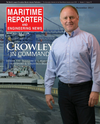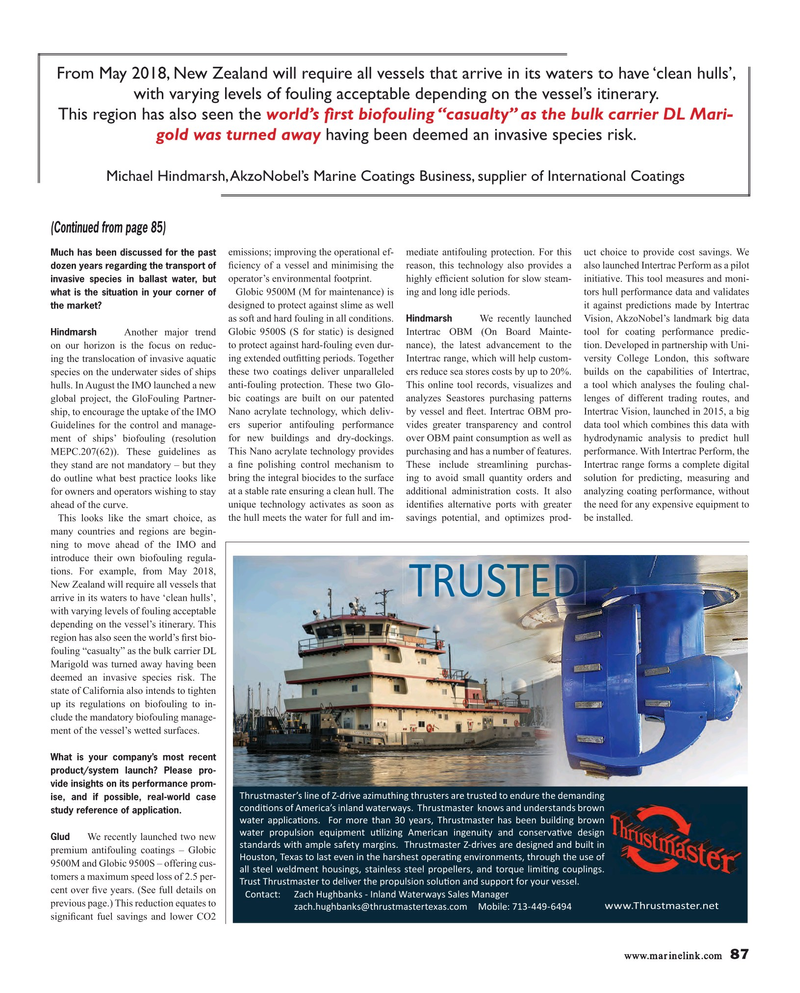
Page 87: of Maritime Reporter Magazine (November 2017)
The Workboat Edition
Read this page in Pdf, Flash or Html5 edition of November 2017 Maritime Reporter Magazine
From May 2018, New Zealand will require all vessels that arrive in its waters to have ‘clean hulls’, with varying levels of fouling acceptable depending on the vessel’s itinerary.
This region has also seen the world’s ? rst biofouling “casualty” as the bulk carrier DL Mari- gold was turned away having been deemed an invasive species risk.
Michael Hindmarsh, AkzoNobel’s Marine Coatings Business, supplier of International Coatings (Continued from page 85) emissions; improving the operational ef- mediate antifouling protection. For this uct choice to provide cost savings. We
Much has been discussed for the past ? ciency of a vessel and minimising the reason, this technology also provides a also launched Intertrac Perform as a pilot dozen years regarding the transport of operator’s environmental footprint. highly ef? cient solution for slow steam- initiative. This tool measures and moni- invasive species in ballast water, but
Globic 9500M (M for maintenance) is ing and long idle periods. tors hull performance data and validates what is the situation in your corner of designed to protect against slime as well it against predictions made by Intertrac the market?
as soft and hard fouling in all conditions. We recently launched Vision, AkzoNobel’s landmark big data Hindmarsh
Hindmarsh Another major trend Globic 9500S (S for static) is designed Intertrac OBM (On Board Mainte- tool for coating performance predic- on our horizon is the focus on reduc- to protect against hard-fouling even dur- nance), the latest advancement to the tion. Developed in partnership with Uni- ing the translocation of invasive aquatic ing extended out? tting periods. Together Intertrac range, which will help custom- versity College London, this software species on the underwater sides of ships these two coatings deliver unparalleled ers reduce sea stores costs by up to 20%. builds on the capabilities of Intertrac, hulls. In August the IMO launched a new anti-fouling protection. These two Glo- This online tool records, visualizes and a tool which analyses the fouling chal- global project, the GloFouling Partner- bic coatings are built on our patented analyzes Seastores purchasing patterns lenges of different trading routes, and ship, to encourage the uptake of the IMO Nano acrylate technology, which deliv- by vessel and ? eet. Intertrac OBM pro- Intertrac Vision, launched in 2015, a big
Guidelines for the control and manage- ers superior antifouling performance vides greater transparency and control data tool which combines this data with ment of ships’ biofouling (resolution for new buildings and dry-dockings. over OBM paint consumption as well as hydrodynamic analysis to predict hull
MEPC.207(62)). These guidelines as This Nano acrylate technology provides purchasing and has a number of features. performance. With Intertrac Perform, the they stand are not mandatory – but they a ? ne polishing control mechanism to These include streamlining purchas- Intertrac range forms a complete digital do outline what best practice looks like bring the integral biocides to the surface ing to avoid small quantity orders and solution for predicting, measuring and for owners and operators wishing to stay at a stable rate ensuring a clean hull. The additional administration costs. It also analyzing coating performance, without ahead of the curve. unique technology activates as soon as identi? es alternative ports with greater the need for any expensive equipment to
This looks like the smart choice, as the hull meets the water for full and im- savings potential, and optimizes prod- be installed.
many countries and regions are begin- ning to move ahead of the IMO and introduce their own biofouling regula- tions. For example, from May 2018,
New Zealand will require all vessels that arrive in its waters to have ‘clean hulls’, with varying levels of fouling acceptable depending on the vessel’s itinerary. This region has also seen the world’s ? rst bio- fouling “casualty” as the bulk carrier DL
Marigold was turned away having been deemed an invasive species risk. The state of California also intends to tighten up its regulations on biofouling to in- clude the mandatory biofouling manage- ment of the vessel’s wetted surfaces.
What is your company’s most recent product/system launch? Please pro- vide insights on its performance prom-
Thrustmaster’s line of Z-drive azimuthing thrusters are trusted to endure the demanding ise, and if possible, real-world case
ÐŽYEsOŽY?ŽIwG?sÐA??sYuAYE?AlG??A???dS???lwA?lG?UYŽ??AYE?YEG??lAYE?d?Ž?Y study reference of application.
?AlG?AÐÐusÐAOŽY??&Ž?wŽ?GlSAY???GA???dS???lwA?lG?SA?dGGYd?suEsYOd?Ž?Y ?AlG?Ð?ŽÐ?u?sŽYG??sÐwGYl?Ous?sYOwG?sÐAYsYOGY?sl?AYEÐŽY?G?|AO|GEG?sOY
Glud We recently launched two new standards with ample safety margins. Thrustmaster Z-drives are designed and built in premium antifouling coatings – Globic ,Ž??lŽY?dG?A?lŽuA?lG|GYsYlSGSA??SG?lŽÐG?AOYOGY|s?ŽYwGYl??lS?Ž?OSlSG??GŽI 9500M and Globic 9500S – offering cus-
Auu?lGGu?GuEwGYlSŽ??sYO???lAsYuG???lGGuÐ?ŽÐGuuG???AYElŽ???GuswsOYOÐŽ?ÐusYO??
tomers a maximum speed loss of 2.5 per- d???ldS???lwA?lG?lŽEGus|G?lSGÐ?ŽÐ?u?sŽY?Žu?OŽYAYE??ÐÐŽ?lIŽ??Ž??|G??Gu?
cent over ? ve years. (See full details on
Contact: Zach Hughbanks - Inland Waterways Sales Manager previous page.) This reduction equates to www.Thrustmaster.net [email protected] Mobile: 713-449-6494 signi? cant fuel savings and lower CO2 www.marinelink.com 87
MR #11 (82-89).indd 87 MR #11 (82-89).indd 87 11/6/2017 3:45:40 PM11/6/2017 3:45:40 PM

 86
86

 88
88
